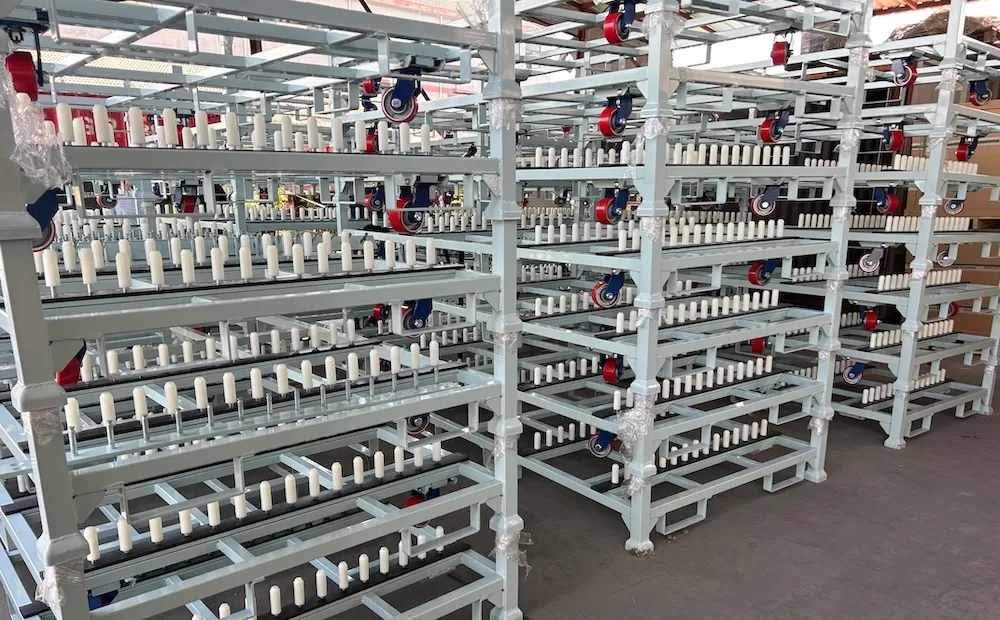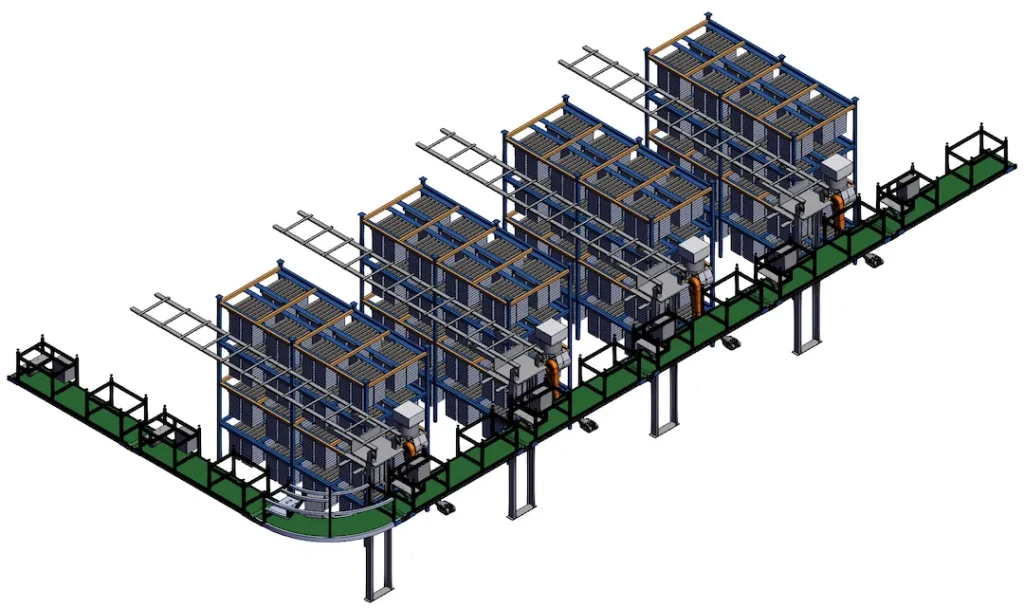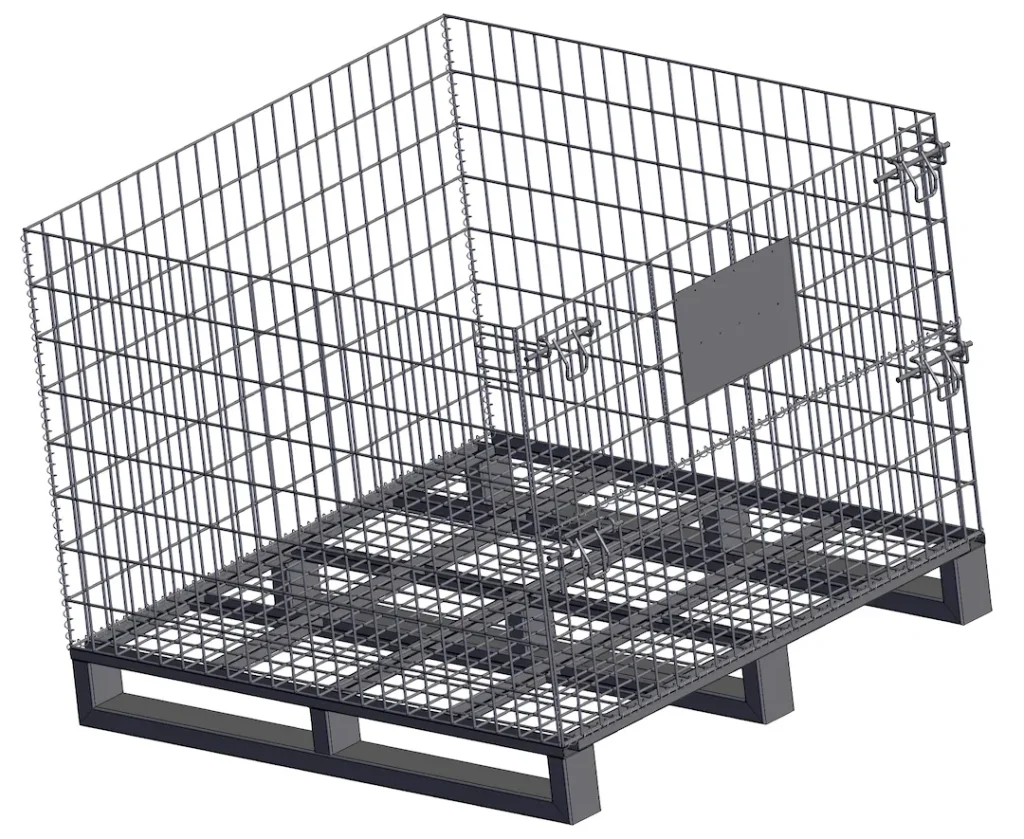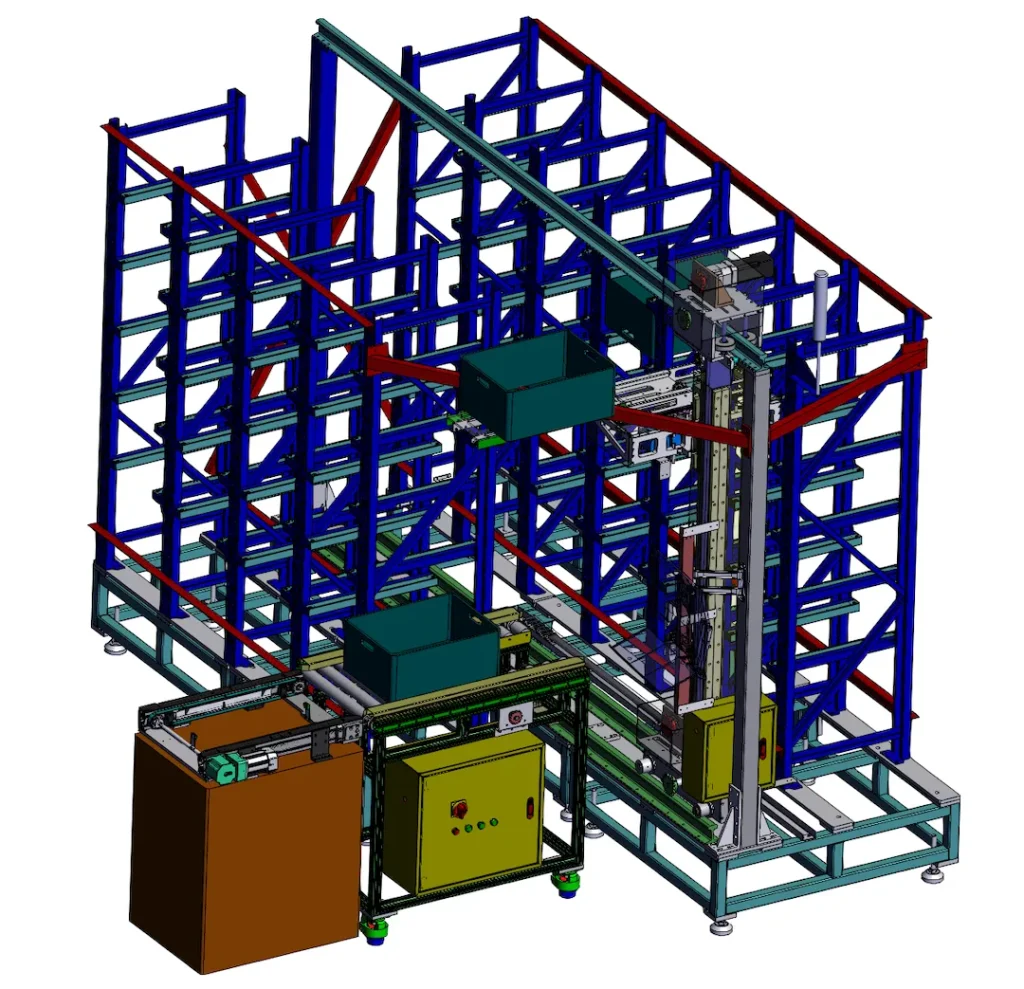
Aperçu & Cas d'utilisation
Able Hardware conçoit et fabrique sur mesure chariots de manutention et racks pour entrepôt, centre de distribution (CC), et opérations 3PL. Construit à partir de tubes et de plaques d'acier de construction avec soudage robotisé MIG, nos chariots, chariots, chariots de préparation de commandes, supports de kitting, et les plates-formes de la taille d'une palette sont optimisées pour la charge utile, ergonomie, et coût du cycle de vie. Nous fournissons des services OEM/ODM et personnalisés aux acheteurs B2B., combinant la découpe laser en amont, Usinage CNC, et assurance qualité prête à l'exportation.
Table des matières
Pourquoi cette solution pour entrepôt & environnements logistiques
Les centres de distribution modernes exigent des équipements durables qui roulent en douceur sur de vrais sols, résiste aux impacts, et survit aux cycles de service continus. Nos conceptions partent de l'enveloppe opérationnelle : charge (150–1 200 kg), devoir (manuel ou tracté), contraintes d'allée, type de sol (béton/époxy/carrelage), et les règles de sécurité. Utiliser des gabarits et des accessoires, nous maintenons l'équerrage et la planéité des assemblages de pont afin que les chariots se déplacent droit et réduisent les forces de poussée/traction. Les finitions thermolaquées ou plaquées protègent dans les environnements humides ou à haut débit, tandis que les modèles de roulettes standard réduisent l'entretien.
Applications typiques dans les entrepôts, DC, et opérations 3PL
- Chariots de préparation de commandes avec étagères réglables et supports pour scanners
- Chariots à palettes et plates-formes antidérapantes pour voies d'entrée/sortie
- Chariots de mise en kit et racks d'alimentation en ligne pour le cross-dock ou l'assemblage léger
- Camions à plateforme pour vrac avec poteaux d'angle amovibles
- Chariots remorqueurs (systèmes mère-fille ou train) pour les courses de lait
Explorer les offres associées: Chariots de soudage, Cadres métalliques personnalisés, Soudage automatique, Découpe au laser & Usinage CNC, Revêtement en poudre, et notre Ressources d'ingénierie.

Propriétés techniques
Matériaux, profils & charges; tolérances & qualité de soudure
- Matériaux & notes: Acier au carbone Q235/S235 et Q355/S355; facultatif 304/316 en inox pour zone hygiénique; 6061/6082 en aluminium pour chariots légers.
- Profils & épaisseur: RHS / SHS, angle, canal, et assiette. Tubes typiques: 30×30×2 à 120×60×4 mm; assiette: 4–20 mm en fonction des charges du plateau et des roulettes.
- Dimensions & charges: Typique L×L×H 600×400×300 à 2000×1200×900 mm. La charge utile cible 150 à 1 200 kg en fonction de la géométrie du cadre, jeu de roulettes, et cycle de service.
- Tolérances: ISO 13920 classe B/C pour les constructions soudées; ISO 2768-m/f pour les dimensions générales. Conseils: planéité du pont ≤ 1,0–2,0 mm; squareité ≤ 1.5 mm/m. Symboles de soudure selon ISO 2553.
- Qualité de soudure: ISO 5817 norme classe C; classe B disponible sur joints visibles ou critiques. Référence structurelle AWS D1.1 si nécessaire. Voir notre ISO 5817 référence.
Finitions & protection contre la corrosion
- Préparation de surface: Sablage/nettoyage selon ISO 8501 qualité comme spécifié.
- Revêtements: Manteau en poudre (70–100 µm RAL), placage de zinc, coat électronique, ou peinture industrielle par environnement.
- Sélection: Aligner sur ISO 12944 catégorie (par exemple., C2 à C4) basé sur l'humidité, produits chimiques, et cycles de nettoyage. Contrôles DFT par ISO 2808.
Options de fabrication
Mig automatique / robotique (et tig si spécifié), gabarits & luminaires, répétabilité
Nous soudons les cadres en MIG automatique/robotique pour plus de rapidité et de répétabilité.; Le TIG est utilisé là où des produits cosmétiques inoxydables ou un contrôle à faible épaisseur sont nécessaires. Les gabarits personnalisés et les goupilles de positionnement garantissent des références reproductibles pour les plaques à roulettes et les montants d'étagères d'un lot à l'autre..
OPS secondaires: coupure laser, pliant, usinage; revêtement & emballage
- Découpe au laser & pliant: Des bords nets, onglets/fentes précis pour un assemblage auto-localisé.
- Usinage CNC: Trous de montage et sièges de roulement de précision.
- Revêtement: Revêtement/placage en poudre en interne ou chez un partenaire avec enregistrements de lots traçables.
- Conditionnement & exporter: Palettisé ou mis en caisse avec un emballage de protection, étiquettes, et pièces/palette optimisées pour le chargement des conteneurs.
Types & Géométrie
Assemblages communs pour entrepôt & logistique (chariots de plate-forme, chariots de préparation de commandes, chariots à palettes, cadres de crémaillère) & bandes de dimensionnement
- Chariots à plateforme: 800Plateaux de ×600 à 1600×800 mm; poteaux d'angle amovibles; garde-corps pour les orteils.
- Chariots de préparation de commandes: 2–4 étagères, 600Empreinte ×400 ou 800×600, supports pour scanner/étiquette, options d'échelle.
- Chariots à palettes: 1200×1000 et 1200×800 mm; protections d'entrée de fourche; oeil de remorqueur ou barre de remorquage pour trains.
- Racks de kitting: Montants modulaires avec bras réglables; fonctionnalités anti-basculement; empreinte définie par la largeur de l'allée.
- Chariots « filles » de remorqueurs: Cadres à profil bas, roulettes à verrouillage central, Géométrie d'attelage pour une articulation fluide du train.
Ingénierie des roulettes: Matériaux des roues PU/nylon/caoutchouc/fonte; diamètres Ø100/125/150/200 mm; roulements (boule/rouleau/plaine). Ensembles typiques: 2 rigide + 2 pivot, ou 4 pivotant avec freins ou verrouillage central. Charger les mathématiques: En tournant, supposer trois roulettes partagent la charge; choisir un facteur de sécurité 1.3–2,0. Exemple: 800 kg de charge utile + 80 chariot kg ≈ 880 kg; charge de conception par roulette ≈ (880/3)×1,5 ≈ 440 kg; sélectionner les roulettes ≥ 440 kg chacun. Faites correspondre la bande de roulement au sol: PU pour époxy/carrelage (faible bruit), nylon pour charges lourdes sur béton lisse, caoutchouc pour sols mixtes.
Ergonomie & sécurité: Hauteur de poignée adaptée à l'opérateur (généralement 900 à 1 100 mm), pare-chocs, protection des coins, protège-orteils, et cibles de bruit. Minimisez les forces de poussée/traction en alignant l'empattement et la sélection des roulements pour acheminer les profils.

Qualité & Essai
Ce que nous vérifions (Vermont, Dft, chèques dimensionnels; PT / MT / RT en option) et documentation (WPS / PQR, Coc)
- Inspection visuelle (Vermont) 100% pour profil à souder, éclabousser, saper, et mélanger les points de la main.
- Contrôles dimensionnels/CMM sur roulettes et repères; planéité du pont et équerrage global selon dessin.
- Revêtement DFT pour ISO 2808 avec lectures enregistrées.
- NDT en option: PT/MT/RT pour les soudures critiques comme spécifié.
- Documentation: WPS/PQR le cas échéant, qualification de soudeur, Coc, et rapports d'inspection alignés sur le bon de commande.
Prix & Délai de mise en œuvre
MOQ, Exemple de politique, Conducteurs de coûts indicatifs (Pas de prix difficiles)
- MOQ: Généralement 50 à 200 pièces par modèle en fonction de la taille et du revêtement.
- Échantillons: Prototype dans les 7 à 15 jours ouvrables après la signature du dessin; outillage remboursable par accord.
- Délai de mise en œuvre: Production 25 à 40 jours + transit, sous réserve de revêtement et de nombre de pièces.
- Facteurs de coûts: Nuance et épaisseur d'acier; type/diamètre des roulettes et systèmes de verrouillage central; classe de soudure (ISO 5817 B contre C); finition (poudre DFT, systèmes multicouches); complexité du gabarit; densité d'emballage (pièces/palette) et les exigences d'exportation. Demandez une fourchette de budget cible et un volume annuel afin que nous puissions concevoir le cadre et l'ensemble de roulettes pour le coût total de possession le plus bas..
Normes & Conformité
Normes / certifications pertinentes & documentation fournie
- Soudage: ISO 5817 (niveaux de qualité), ISO 2553 (symboles); référencer AWS D1.1 pour les critères structurels si nécessaire.
- Tolérances de fabrication: ISO 13920 (constructions soudées), ISO 2768-m/f (général).
- Revêtements: ISO 8501 (préparation), ISO 12944 (protection contre la corrosion).
- Dossiers de qualité: WPS / PQR, diplôme de soudeur, inspection & Rapports DFT, CoC disponible avec expédition.

FAQ
Q1: Quels matériaux recommandez-vous pour les chariots DC?
Q235/S235 pour service standard; Q355/S355 pour des charges utiles plus élevées; 304/316 en inox pour l'hygiène; 6061/6082 aluminium lorsque la réduction de poids ou la manipulation manuelle sont critiques.
Q2: Comment sélectionner les roulettes et vérifier la charge?
Taille par charge de rotation la plus défavorable (trois roulettes portant) avec un facteur de sécurité de 1,3 à 2,0. Choisissez Ø150–200 mm pour les sols tirés ou rugueux; PU pour un faible bruit sur époxy, nylon pour charges lourdes sur béton lisse.
Q3: Quelles tolérances pouvez-vous respecter sur les cadres?
ISO 13920 classe B/C avec ISO 2768-m/f; planéité typique du pont ≤ 1–2 mm et équerrage ≤ 1.5 mm/m à l'aide de gabarits et d'un séquencement de soudure contrôlé.
Q4: Quelle classe de soudure fournissez-vous?
ISO 5817 classe C en standard; classe B pour les joints visibles ou critiques. Symboles de soudure selon ISO 2553.
Q5: Quels revêtements conviennent?
Revêtement en poudre 70–100 µm (Ral) pour la plupart des DC; zingage ou revêtement électronique pour la résistance à l'abrasion/à la corrosion; spécifier ISO 12944 catégorie environnement.
Q6: Quel est le MOQ habituel et le délai de livraison?
Les MOQ commencent à 50-200 pièces; délai de livraison 25 à 40 jours après l'approbation de l'échantillon. Les lots urgents peuvent être divisés par accord.
Q7: Quels dessins acceptez-vous?
STEP/IGES/SolidWorks et PDF annotés avec des données critiques, classe de soudure, tolérances, et spécifications de revêtement. Nous pouvons vous aider via notre Ressources d'ingénierie.
Téléchargez votre demande de prix pour commencer
Envoyez vos fichiers 3D/2D et vos exigences (charge utile, type de sol, cycle de service, finition, spectre). Nous concevrons un ensemble de chariots ou de supports rentables pour vos allées.